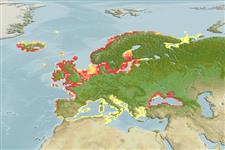Classification / Names
Common names from other countries
Main reference
Size / Weight / Age
Max length : 140 cm SL male/unsexed; (Ref. 682); common length : 72.0 cm TL male/unsexed; (Ref. 3397); max. published weight: 50.0 kg (Ref. 682); max. reported age: 38 years (Ref. 32682)
Length at first maturity
Lm 16.1, range 1 - 600 cm
Environment
Marine; freshwater; brackish; pelagic-neritic; anadromous (Ref. 51243); depth range 0 - 28 m (Ref. 101587), usually 1 - 2 m (Ref. 101587)
Climate / Range
Subtropical; 18°C - 24°C (Ref. 12741), preferred 9°C (Ref. 107945); 71°N - 34°N, 25°W - 57°E
Distribution
Europe and Asia: Atlantic, North, White and Baltic Sea basins, from Spain to Chosha Bay (Russia). Found in Iceland and northernmost rivers of Great Britain and Scandinavia. In Rhône drainage, native only to Lake Geneva basin, which it entered after last glaciation. Native to upper Danube and Volga drainages. Introduced widely. Several countries report adverse ecological impact after introduction.
Countries | FAO areas | Ecosystems | Occurrences | Introductions
Short description
Dorsal
spines
(total): 3 - 4;
Dorsal
soft rays
(total): 10-15;
Anal
spines: 3-4;
Anal
soft rays: 9 - 14;
Vertebrae: 57 - 59. Fusiform body (Ref. 51442). Head little and pointed (Ref. 51442). Mouth large, extending mostly after the eye and has well developed teeth (Ref. 51442). Teeth on shaft of vomer numerous and strongly developed (Ref. 7251). Caudal fin with 18-19 rays (Ref. 2196). Caudal peduncle thick and rounded (Ref. 51442). Little scales (Ref. 51442). Body is grey-blue colored with numerous spots, also below the lateral line (Ref. 51442). Blackish colored on upper part of body, usually orange on sides, surrounded by pale halos. Adipose fin with red margin.
IUCN Red List Status (Ref. 115185)
Threat to humans
Potential pest
Human uses
Fisheries: commercial; aquaculture: commercial; gamefish: yes
Tools
Special reports
Download XML
Internet sources
Estimates of some properties based on models
Phylogenetic diversity index
PD50 = 0.5000 many relatives (e.g. carps) 0.5 - 2.0 few relatives (e.g. lungfishes)
Trophic Level
3.4 ±0.1 se; Based on diet studies.
Resilience
High, minimum population doubling time less than 15 months (rm=0.9; K=0.09-0.8; tmax=8; Fec=1,000)
Vulnerability
High vulnerability (60 of 100)
Price category
